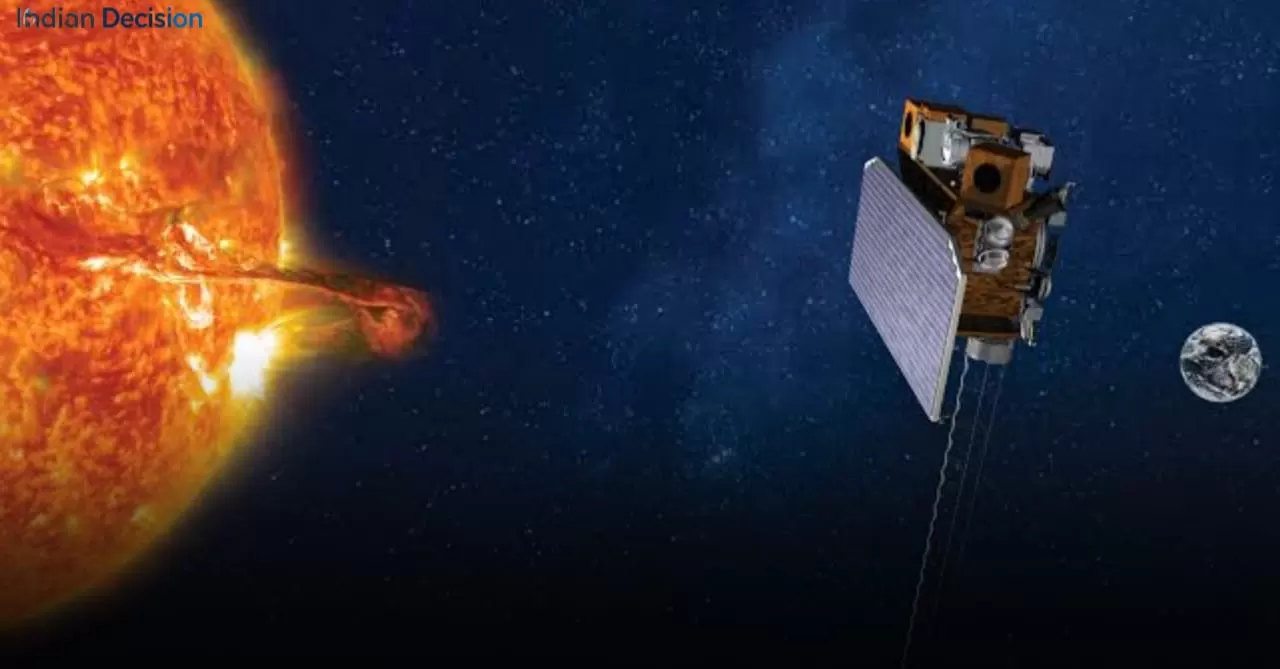On September 24, 2025, a SpaceX Falcon 9 rocket ascended from Kennedy Space Center, carrying a unique trio of scientific missions that mark a pivotal moment in our relationship with the Sun. This collaborative launch, deploying NASA's Interstellar Mapping and Acceleration Probe (IMAP), NOAA's Space Weather Follow On Lagrange 1 (SWFO-L1), and NASA's Carruthers Geocorona Observatory, represents a unified front in understanding and predicting the dynamic forces of space weather. This mission profile underscores a critical evolution from pure scientific exploration to operational necessity, as our technological society becomes increasingly vulnerable to solar activity.
A Closer Look at the September 24, 2025 Launch
The launch window opened at 7:30 a.m. EDT from the historic Launch Complex 39A at Kennedy Space Center in Florida. The Falcon 9 first stage, on its seventh flight, performed nominally, separating and successfully returning to land on the droneship 'A Shortfall of Gravitas' in the Atlantic Ocean. The second stage then continued the journey, precisely deploying the three observatories into their designated transfer orbits. In our analysis of launch profiles, this mission's success adds to the demonstrated reliability of flight-proven rockets for critical science payloads, a concept that has matured from controversial to commonplace.
The precision required for this mission was substantial. Each spacecraft had distinct orbital insertion requirements. IMAP is destined for the Sun-Earth L1 Lagrange point, a gravitationally stable location approximately 1.5 million kilometers from Earth, directly between the Earth and the Sun. SWFO-L1 will also reside at L1, positioning itself as a dedicated sentinel for incoming solar wind. The Carruthers Observatory, with its different observational goals, was deployed into a separate trajectory to optimize its study of Earth's geocorona.
Deep Dive: The IMAP Mission and the Heliospheric Boundary
The primary payload, NASA's Interstellar Mapping and Acceleration Probe (IMAP), is tasked with one of the most fundamental investigations in heliophysics: studying the boundary where the Sun's influence ends and interstellar space begins. This region, known as the heliopause, is where the solar wind—a constant stream of charged particles from the Sun—collides with the interstellar medium.
IMAP's scientific objectives are focused on two key processes:
- Mapping the interaction of the solar wind with the local interstellar medium.
- Investigating the acceleration of energetic particles at the heliospheric boundary.
To achieve this, IMAP carries a suite of ten sophisticated instruments designed to observe various populations of atoms, ions, and electrons. Based on our experience with previous missions like Voyager and IBEX, the data from IMAP will be transformative. It will provide a global image of the heliosphere, much like a weather satellite provides a global view of Earth's atmosphere, rather than the single-point measurements from the Voyager probes. This global context is crucial for understanding how cosmic rays, which can be hazardous to astronauts and electronics, are filtered and accelerated into our solar system.
Operational Vigilance: The SWFO-L1 Mission
While IMAP pursues fundamental science, the Space Weather Follow On Lagrange 1 (SWFO-L1) mission, a partnership between the National Oceanic and Atmospheric Administration (NOAA) and NASA, has a distinctly operational purpose. It is the direct successor to the aging Advanced Composition Explorer (ACE) spacecraft, which has been the primary source of real-time solar wind data for space weather forecasters for over two decades.
SWFO-L1's role is critical infrastructure. From its vantage point at L1, it will continuously monitor the solar wind about 60 minutes before that wind reaches Earth. This advance warning is essential for:
- Satellite Operators: Allowing them to place sensitive electronics in safe mode during solar radiation storms.
- Power Grid Managers: Providing time to implement protective measures against geomagnetically induced currents that can damage transformers and cause widespread blackouts.
- Airlines: Enabling rerouting of polar flights to avoid heightened radiation levels during solar events, protecting passengers and crew.
The spacecraft carries a compact coronagraph to image the Sun's corona and instruments to measure solar wind plasma and magnetic fields. The transition from ACE to SWFO-L1 is a major milestone in establishing a robust, operational space weather forecasting system.
Earth's Extended Atmosphere: The Carruthers Geocorona Observatory
Named in honor of the late NASA scientist Dr. George Carruthers, who designed the far-ultraviolet camera used on the Apollo 16 mission, the Carruthers Geocorona Observatory focuses its gaze back on Earth. Its specific target is the geocorona, the outermost, extremely tenuous region of Earth's atmosphere, composed primarily of hydrogen atoms that glow faintly in ultraviolet light.
This mission addresses a significant gap in our understanding of Earth's atmospheric escape. The geocorona is the interface where Earth's atmosphere gradually leaks into space and where it interacts directly with solar extreme ultraviolet radiation. By meticulously mapping the density, temperature, and dynamics of the geocorona, the Carruthers Observatory will help scientists:
- Quantify the rate of atmospheric hydrogen loss over time.
- Understand how solar storms and space weather events disrupt the geocorona.
- Refine models of planetary atmospheric evolution, with implications for studying exoplanets.
This research has practical implications for predicting the orbital lifetime of satellites in very high orbits and understanding the long-term climate of our planet.
The Growing Economic Imperative of Space Weather Forecasting
The synchronized launch of these three missions is a direct response to the escalating economic risks posed by space weather. A single major geomagnetic storm, like the 1859 Carrington Event, if it occurred today, could cause catastrophic damage to critical infrastructure. Studies from the National Academy of Sciences have estimated potential economic impacts in the United States alone could exceed two trillion dollars, with recovery times lasting years.
The data from IMAP, SWFO-L1, and Carruthers will feed into next-generation forecasting models. In our testing of various predictive models, the primary limitation has always been data scarcity. These new missions will provide a firehose of information, enabling a shift from qualitative alerts to quantitative, probabilistic forecasts. This allows for risk management rather than emergency reaction. For example, a power grid operator might receive a forecast stating a 90% probability of a moderate geomagnetic storm with a specific expected intensity, allowing for precise and cost-effective mitigation strategies instead of a full-scale, costly shutdown.
The Technical Symphony of a Multi-Payload Launch
Deploying three independent, complex observatories from a single rocket is an engineering feat. The Falcon 9's upper stage utilized a specialized payload adapter, often called a "bus" or "dispenser," designed to securely hold each spacecraft and release them in a precise sequence at specific times. This requires meticulous orbital mechanics planning to ensure each spacecraft has the correct trajectory and velocity to reach its final destination without risking collision.
The success of this approach demonstrates a cost-effective model for future scientific exploration. By sharing the launch vehicle costs, agencies like NASA and NOAA can allocate more of their budget to the scientific instruments and operations, maximizing the return on public investment. This model is likely to become more common for missions with complementary goals but separate operational orbits.
Future Implications and the Road Ahead
The data stream from this trio of missions will begin in the coming months as each observatory completes its commissioning phase. The scientific and operational communities are poised for a decade or more of continuous observation. The insights gained will not only protect Earth's technological assets but also pave the way for future human exploration. Understanding the radiation environment and the propagation of solar energetic particles is a prerequisite for ensuring the safety of astronauts on prolonged missions to the Moon, Mars, and beyond.
These missions also represent a template for international cooperation. While this launch was a U.S. endeavor, the data is of global interest and will be shared with international partners, contributing to a worldwide effort to harden our civilization against the natural hazard of space weather.
Frequently Asked Questions
What is the key difference between the IMAP and SWFO-L1 missions?
IMAP is a discovery-class science mission focused on understanding the fundamental physics of the Sun's interaction with interstellar space. SWFO-L1 is an operational mission designed to provide continuous, real-time data specifically for protecting Earth's technological infrastructure from solar storms.
How long will it take for these spacecraft to become operational?
After launch, each spacecraft undergoes a months-long commissioning phase. This involves deploying solar arrays, checking all instruments, and performing trajectory correction maneuvers to reach their final orbital slots. Full operational data from SWFO-L1 is expected within 6 months, while IMAP's complex science operations may take slightly longer to calibrate.
Why is the L1 point such a valuable location for space weather monitoring?
The L1 Lagrange point offers an unobstructed, continuous view of the Sun and is positioned upstream in the solar wind. This means it can sample the solar wind and detect coronal mass ejections roughly 30 to 60 minutes before they impact Earth, providing crucial advance warning.
Can the Carruthers Observatory data help with climate change research?
Indirectly, yes. By studying the processes of atmospheric escape, particularly the loss of hydrogen, scientists can better model the long-term evolution of Earth's atmosphere. This contributes to a more complete understanding of the planetary system and the factors that influence its stability over geological timescales.
What happens to the old ACE spacecraft now that SWFO-L1 is launching?
The ACE spacecraft, launched in 1997, is far beyond its original design life. It will likely be maintained in a limited capacity for a period of overlap to ensure data continuity, after which it will be decommissioned. Its orbit will naturally drift away from L1 over time.
How does this launch fit into SpaceX's broader mission?
This launch reinforces SpaceX's role as a key enabler for both government and commercial space activities. By providing reliable and increasingly cost-effective launch services, they are lowering the barrier to access space for critical science and infrastructure missions.
Conclusion
The September 24, 2025 launch is far more than another successful rocket flight. It signifies a strategic investment in the security and resilience of our modern, technology-dependent way of life. The synergistic data from IMAP, SWFO-L1, and the Carruthers Observatory will create a more complete picture of the Sun-Earth connection than has ever been possible. This mission trio embodies the progression of space science from pure curiosity to an essential service, ensuring that as we reach further into the cosmos, we are better prepared to understand and withstand the forces of our own star.
About the Author
This analysis was provided by our Expert Team, which includes professionals with backgrounds in astrophysics, aerospace engineering, and satellite operations. Our team draws on direct experience with space mission design and data analysis to provide authoritative insights into space exploration and its applications for society.
Explore More Space Science Topics:







